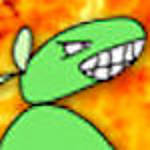Quoted Text
the argument is furthered by saying that what is seen on modern military vehicles compared to German WWII paint is comparing apples and oranges. i am asked to accept that as fact on one had while on the other i know we have military technological marvels like the Leclerc, Leopard 2, Challenger II, and Abrams, but for the past 5 decades we can't make paint as durable as the Germans did over 60 years ago? again, that's a pretty bold claim.
In debating circles this is referred to as a "non sequitor"...meaning literally "it does not follow". Take, for example, the case of primitive cave/rock art around the world. There's a site close by to where I live called Hueco Tanks which had problems with graffiti over the past decades with ancient rock art side-by-side with it. The modern inks/paints used to create the graffiti have not stood up well against the tests of time over just the space of a few short decades having faded severely and, in some cases, been erased literally by time vs. art created with very primitive (by our standards) pigments and application methods that's hundreds if not thousands of years old. My point here is simple...modern paint, while certainly more advanced chemically, better for the environment, etc. is not
the same as the paint used in World War 2. Comparing how vehicles painted with modern paints behave is indeed an "apples to oranges" exercise for many reasons.
There's a reason why lead-based paints were used...they were highly durable and tough, providing effective anti-corrosion protection for extremely expensive (relative to the time) armor plated vehicles (not to mention protecting the lives of the crews) and were maintained by their crews on a regular basis in the field directly as well as supported by field maintenance units. There's a reason why they were primered and basecoated at the factories (right up to the very end of the war), because this was a critical element in their manufacture process before acceptance as combat-ready vehicles by the Heer, SS, Luftwaffe, etc. The Germans didn't scrimp on this no matter the popular conception of the "end of the war chaos" theories that abound as justification for aesthetically pleasing approaches to weathering/finishing vehicles, especially late war vehicles (a perverse application of logic in its own right but I digress).
Did chipping occur on vehicles in WW2? Most certainly, but just as you mention with the modern crews (where there is a good analog to compare to), the crews were tasked with maintaining their vehicles and keeping them in good fighting condition at all times when not in direct combat. The anecdotal/memoir evidence supporting this abounds...AFVs had multi-man crews and those crews were responsible for the day-to-day maintenance and upkeep of their vehicles which would include keeping rust and paint damage at bay. Major damage from combat (your example of shell bursts, collisions, accidents with buildings, etc.) would be repaired, including repaint, as quickly as possible by the field maintenance units where needed to keep the vehicle in good fighting condition and where such damage would hinder the combat effectiveness of the vehicle in question.
These comments do not in any way discount the real-life experiences of those who've commented in this thread. Those experiences are valid in the context in which they happened, it's just not a guarantee that those same experiences also applied to a different context as those conditions, while potentially similar in many ways, have their own variables. Those variables include time in service, field maintenance practices, paint composition and methods of application, environmental conditions, etc. that are different.















































